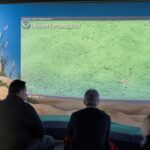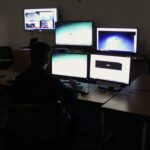Today was the final day of a month-long telepresence-enabled expedition conducted by NOAA’s Office of Exploration and Research and partners, aboard the NOAA Ship Okeanos Explorer in order to collect critical baseline information on poorly understood deep-sea habitats of the Gulf of Mexico. Despite the Gulf’s proximity to land and significant industrial footprint, many seafloor areas have yet to be explored, including a wide variety of fascinating habitats ranging from deep-sea coral gardens, submarine canyons, gas and oil seeps, mud volcanoes, to submerged cultural heritage sites. NCCOS supported the mission via a recently established exploration command center at the Hollings Marine Laboratory in Charleston, where scientists from the Deep Coral Ecology Laboratory (DCEL) participated in dive planning and annotated biological observations of live video. Additionally, live video feeds from the expedition were streamed at the South Carolina Aquarium, where DCEL staff members provide science interpretation to the general public.
For more information, contact Daniel.Wagner@noaa.gov.



